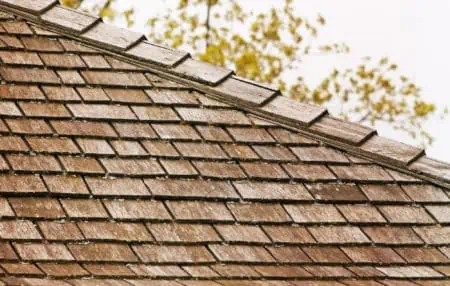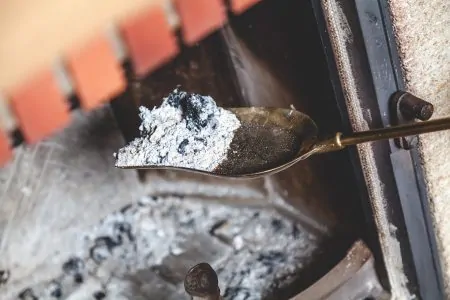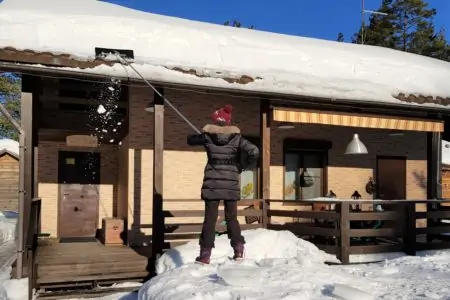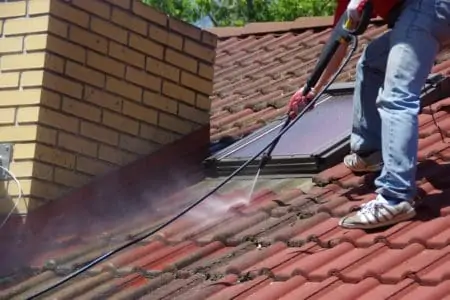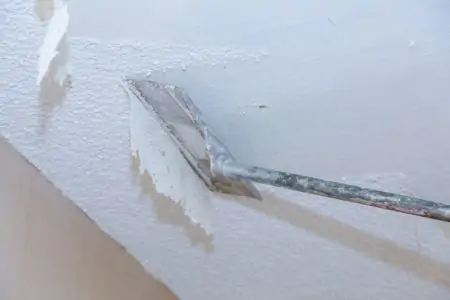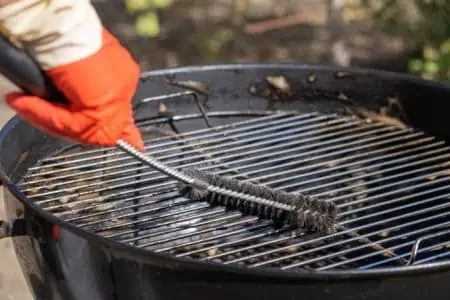Nothing is more unsightly than stains and streaks of algae and dirt running down the asphalt shingles of a roof. The streaks and stains are caused by dirt, algae, and mold on your roof. Don’t worry, you don’t need to hire a professional.
Instead, you can learn how to clean a shingle roof yourself.
Key Takeaways
- Use a 50:50 mixture of household chlorine bleach and water to clean asphalt shingle roofs.
- Apply the solution with a garden sprayer and rinse off with a low-pressure garden hose after 20-30 minutes.
- Avoid pressure washing shingle roofs, as it can cause damage and premature aging.
- To prevent algae regrowth, install algae-resistant shingles or trim trees to allow more sunlight on the roof.
What Is the Best Cleaner For Roof Shingles?
When cleaning roof shingles, there are several excellent cleaners you can use.
Two cleaners you can use to spray on your roof and then leave are Spray & Forget or Wet & Forget. You can also use chlorine bleach and water to clean your roof as the sodium hypochlorite in chlorine bleach is effective for cleaning algae, fungi, and moss. A third option is sodium hydroxide which is also known as lye.
In addition to these cleaners, you will also need a ladder, garden sprayer, hose, and a safety rope or harness.
Roof Cleaning Solution Recipe
An easy and effective homemade roof cleaning solution you can use is to mix water and chlorine bleach in a 50:50 ratio. Put the solution in a garden sprayer and use it on your roof. This will remove the algae and moss from your roof.
Is It Safe to Pressure Wash a Shingle Roof?
No, it’s not safe to pressure wash a shingle roof. The water pressure is too great and will damage the surface of the roof. Granules come off and go into the gutter which ages the roof prematurely.
In addition, the water may damage the underlying materials of the roof.
Soft washing is different from pressure washing a roof. You will spray a biodegradable cleaning solution that will work its way into the crevices and undersides of your roof. Then it’s rinsed off gently with low-pressure water like you’d find coming out of a garden hose.
Will Bleach Damage Roof Shingles?
No, a DIY 50-50 bleach solution is recommended in many cases and should not damage your roof shingles. However, always check with your manufacturer to make sure that it’s safe for your specific type of shingle.
However, undiluted bleach can damage the metal roof flashings, gutter, and drain spouts connected with your roof. It may also lighten the color of your roof.
How to Clean Roof Shingles
When you’re cleaning your roof shingles, keep in mind that safety comes first. Make sure that you have a safety harness and non-slip shoes. Wear goggles, a long-sleeved shirt, and pants so you don’t accidentally expose your skin to any chemicals.
- Time: 2-5 hours
- Difficulty: Advanced
What You’ll Need
- Full body safety harness
- Nonslip shoes
- Ladder
- Safety goggles
- Gloves
- Garden hose
- Garden hose nozzle
- Noncorrosive roof cleaner
- Garden sprayer
1. Safety First
Choose a cool or overcast day with no wind. You don’t want to be blown off the roof. Also, a cool or overcast day will allow the cleaning solution time to seep into the algae and moss colonies because it won’t evaporate as quickly.
Wear slip-resistant shoes and a safety rope or harness to prevent falls. Algae and moss can be slippery. Also consider safety goggles, thick gloves, long sleeves, and pants to prevent exposure to chemicals.
2. Prepare Surroundings
Prepare your surroundings before you begin. Remove any debris on the roof or in the gutter. This will make it easier to clean your roof.
Also move lawn chairs, pottery, and other landscaping items that could be sprayed in the process. You’ll be spraying dirty water and this will save time cleaning up your yard when you’ve finished cleaning your roof.
Spray down all the plants in your yard as well. This will help to keep your plants from absorbing the chemicals and potentially killing the plants.
3. Prepare Solution
Prepare your solution by mixing a 50:50 chlorine bleach solution. You can also use a different roof shingle cleaner that’s safe for your shingles. Make sure that you’ve made enough of the solution for your roof.
Put the solution into a garden sprayer, remember to always use a low-pressure sprayer that won’t damage your roof.
4. Apply to Roof
Spray your roof with the cleaning solution. You’ll need to spray every single shingle. Also, make sure that you give any algae or moss a good drenching of the solution.
If the cleaning solution evaporates while you’re spraying, respray the area.
Wait 20 minutes before rinsing.
5. Rinse
Use a garden hose and nozzle to rinse your roof. Remember to use low pressure.
Be thorough as you rinse your roof. If you see algae, you can use a medium bristled broom to scrub it. Be gentle as you don’t want to damage the shingles.
When you’ve finished, spray the plants in your yard again to remove the chemicals. This will help prevent the chemicals from killing your shrubbery.
If needed, you can repeat the steps to apply the cleaner a second time.
How to Prevent Algae Regrowth
There are a few things you can do to prevent algae from growing on your roof.
- One solution is to apply zinc and copper strips when you’re installing your roof. Zinc and copper kill the algae on your roof. However, it’s not recommended to add it to an existing roof. This is because you’ll end up with exposed nails which can cause leakage, or you could end up breaking the sealant bond which may cause wind damage.
- Install algae-resistant shingles when you’re installing a new roof. These are shingles made with copper granules to prevent algae growth on your roof.
- Trim back the trees to allow more sunlight on your roof and kill any algae or moss.
- Remove debris from your roof.
- Keep your gutters clean. This will promote good water drainage.
